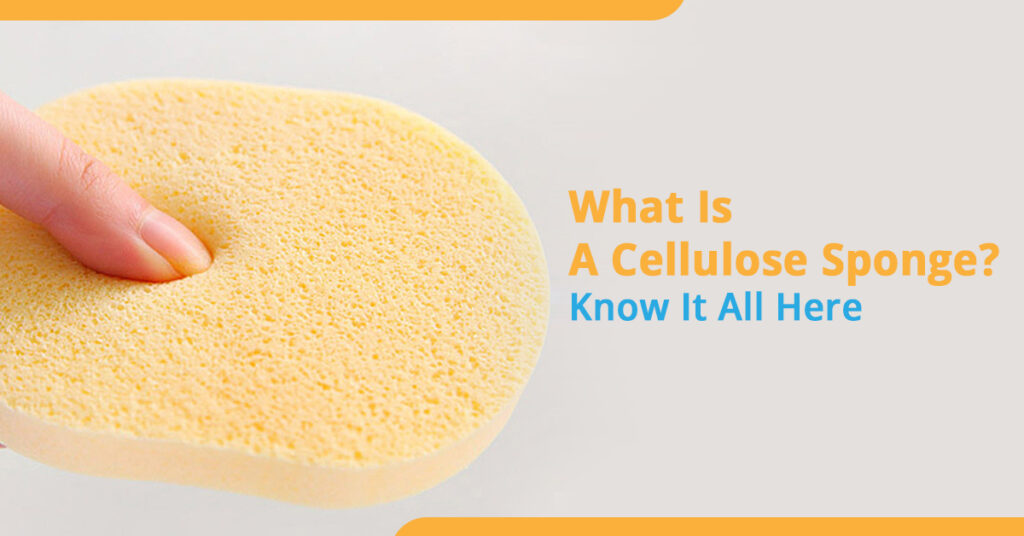A cellulose sponge, also known as Swedish dishcloth or European dishcloth, is a cellulose sponge cloth made with cellulose and cotton fibers. These sponges can be seen everywhere.
Due to its quick-absorbing feature, people use it in place of other types of sponges and single-use towels. The average life of a cellulose sponge is six months. Many sponges that you see in your home kitchen are cellulose ones.
These are the best options to hold large amounts of liquid, and these can work fine on many surfaces. You get these in different shapes, types, sizes, and colors, and they are versatile, soft, and durable. To clean dishes, you need kitchen sponges, and the cellulose ones are the best.
The common sponge is a soft cleaning material and easily absorbs a large volume of liquid. The tool is ideal for general household cleaning, car spills, wiping mirrors, and tiling and decorating applications.
What Is A Cellulose Sponge Made Of?
Pure cellulose sponge consists of wood fibers. They are biodegradable in landfills, and the manufacturing process isn’t more toxic than plastic. The sponge should be made of cellulose material without polyester filling. The tiny holes in these sponges ensure the sponge soaks the highest amount of liquid.
These sponges contain cellulose, referred to as recyclable non-petroleum vegetable fiber or an all-natural wood fiber material. Sponge manufacturers later change these to wood pulp to make a natural cellulose sponge.
Materials Used in Cellulose Sponges: The cellulose sponge consists of wood pulp, so the holes within the sponge can absorb liquid easily and keep it inside for a long time. The tiny sponges are soft inside with sealed packing. Manufacturers wash these with soap to keep them flexible. Also, this process reduces the bacteria within the package before purchasing. So, you should thoroughly rinse these sponges before using them.
Common Uses Of Cellulose Sponges
Cellulose sponges are handy for household chores like bathroom, kitchen, and general cleaning. It makes them the most common type of sponges in the kitchen. You can be used for cleaning countertops, appliances, floors, sinks, etc.
In the kitchen, a cellulose sponge also works well for bathroom cleaning like basins, glass, countertops, tiles, etc. Since the sponge soaks soap or heat, you shouldn’t use it to wipe things like raw eggs or meat juice where bacteria growth occurs.
For bathroom and kitchen use, tradesman and DIY experts also use cellulose sponges. Their common uses include wallpaper, drywall, grout and tiles, pottery, and other housework.
How Manufacturers Make Cellulose Sponges?
Manufacturers make cellulose sponges by mixing softeners, wood pulp (cellulose), and sodium sulfate crystals. Flax, with other things, makes a mix of strength, chemical resistance, and other properties. To make a cellulose sponge, manufacturers use stiff wood pulp sheets.
They mix large sheets with water softeners to form a jelly-like slurry. After completing the mix, pour it into the mold and heat. The sodium sulfate crystals also melt when the mix drains and cooks.
The sodium sulfate crystal’s size is what tells the pore size in the product’s outcome.
Cellulose sponge for car wash must be more porous with larger crystals. However, fine pore sponges use finer crystals like those for makeup.
Later the heat mix cools down and hardens as a porous block. Then it can be soaked in a bleach mix to remove impurities and dirt. With bleaching, you also get bright cellulose colors. After you bleach, you must wash the block with water until you get the flexible texture. After drying the sponge block, they get the shape of thick sponges. Now they are ready to sell on the market.
Cleaning Process Of Cellulose Sponge?
To ensure it works fine, you must rinse the sponge in running warm water after each use. Squeeze excess water and let it dry. You can use a rack for drying. Then, microwave the sponge for 2 minutes on high heat once every few days. Also, you can put the sponge in the dishwasher on the top rack and clean it. Ensure that you don’t have any soap left in the sponge before putting it in.
Replace these sponges in a few weeks or six months (sooner when they look dirty).
Can You Use Cellulose Sponges Instead Of Regular Sponges?
Yes, you can! For a better answer, a cellulose sponge can easily absorb water because of its fiber phenomenon making air bubbles inside cellulose. These bubbles can hold water 20 to 30 times more than their weight.
They have higher heat resistance than polyurethane sponges, and their shape and design don’t change up to 140 C.
Environment Benefits Of Cellulose Sponges
The cellulose sponge has Triclosan and Polyurethane compounds. When they burn, they emit toxic-free gas and don’t dispose of carbon dioxide. It means that the sponge is 100% earth-friendly. After the product is useless, you can put it in a compost bin, waste bin, or bury it in your garden.
Disadvantages Of Cellulose Sponges
The large cellulose sponge often traps dirt and mold, so you can’t clean them with only rinsing. You can toss cellulose sponges in the dishwasher to clean out dirt effortlessly. Dirt present at all times in the sponge can reduce its life and cause it to emit a foul smell. You cannot use a cellulose sponge for jobs where bacteria growth occurs. You can try a paper towel instead.
Cellulose Wipes As An Alternative
Another thing you can try is a cellulose wipe, as this is a flatter option. You can use a flat rectangular large cellulose sponge instead of paper towels to polish or dust. You can reuse them with proper care.
Final Words
So, what would be the best cellulose sponge for you? You can notice a good cellulose sponge cloth by the materials it is made up of. Avoid sponges with polyfill. Also, only look for cotton or cellulose fibers with biodegradable elements. Sponge Center offers the most biodegradable and long-lasting cellulose sponges to make cleaning an easy and fun process. Sponge Center makes the most natural cellulose sponge of top-notch quality while maintaining the standards. These sponges are soft on surfaces but hard on germs. Squeeze away those hard-to-clean stains for shiny surfaces.

